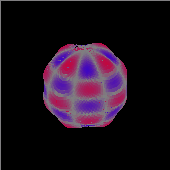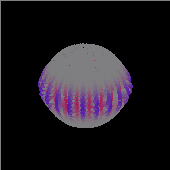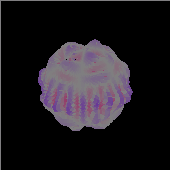



The second example is a little misleading : in reality the oscillations with m different from 0 correspond to waves, that run around the Sun, as shown in this version of the film. This effect enables us to study the solar rotation using the oscillations : waves that move in the same direction as the rotation look as if they have a slightly higher frequency, and waves moving against the rotation look as if they have a somewhat lower frequency. This effect is very similar to the Doppler effect.
However, it is easier to see what happens by following the waves around the Sun, and that is what we are doing in the following cases.
In reality the Sun oscillates with a very large number of modes simultaneously. Even the effect of adding just three modes with different amplitudes and frequencies becomes quite complicated. The effect is shown here : every image activates a small film that shows the oscillation :
 +
+
 +
+
 =
=
